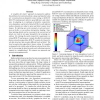Free Online Productivity Tools
i2Speak
i2Symbol
i2OCR
iTex2Img
iWeb2Print
iWeb2Shot
i2Type
iPdf2Split
iPdf2Merge
i2Bopomofo
i2Arabic
i2Style
i2Image
i2PDF
iLatex2Rtf
Sci2ools
106
click to vote
CVPR
2003
IEEE
2003
IEEE
ROD-TV: Reconstruction on Demand by Tensor Voting
A “graphics for vision” approach is proposed to address the problem of reconstruction from a large and imperfect data set: reconstruction on demand by tensor voting, or ROD-TV. ROD-TV simultaneously delivers good efficiency and robustness, by adapting to a continuum of primitive connectivity, view dependence, and levels of detail (LOD). Locally inferred surface elements are robust to noise and better capture local shapes. By inferring per-vertex normals at sub-voxel precision on the fly, we can achieve interpolative shading. Since these missing details can be recovered at the current level of detail, our result is not upper bounded by the scanning resolution. By relaxing the mesh connectivity requirement, we extend ROD-TV and propose a simple but effective multiscale feature extraction algorithm. ROD-TV consists of a hierarchical data structure that encodes different levels of detail. The local reconstruction algorithm is tensor voting. It is applied on demand to the visible sub...
Computer Vision | CVPR 2003 | Inferred Surface Elements | Local Reconstruction Algorithm | Tensor Voting |
| Added | 04 Jul 2010 |
| Updated | 04 Jul 2010 |
| Type | Conference |
| Year | 2003 |
| Where | CVPR |
| Authors | Wai-Shun Tong, Chi-Keung Tang |
Comments (0)

